Most people who use an inhaler for asthma or COPD think they’re doing it right. They shake it, press the button, and breathe in. But here’s the hard truth: 70 to 90% of people use their inhaler incorrectly. That means up to 90% of the medicine never reaches your lungs. Instead, it lands in your mouth or throat - wasting medication, increasing side effects, and leaving your symptoms poorly controlled.
Why Technique Matters More Than the Inhaler Itself
Your inhaler is a precision tool. It’s designed to deliver a specific dose of medicine directly to your airways. But if you don’t use it right, you might as well be spraying water into your mouth. The difference isn’t small. With perfect technique, 80% of the medication reaches your lungs. With poor technique? That number drops to 10-20%. That’s not just inefficient - it’s dangerous.When medicine stays in your mouth, it causes thrush (a fungal infection), hoarseness, and sore throat - especially with steroid inhalers like Flovent or Advair. It also means you’re not getting the full benefit. You might end up using your rescue inhaler more often, visiting the ER more frequently, or even being hospitalized because your controller medication isn’t working.
The good news? Fixing your technique doesn’t require new equipment. It doesn’t cost extra. It just requires learning the right steps - and doing them every single time.
Step-by-Step: How to Use a Metered-Dose Inhaler (MDI) Correctly
Most people use metered-dose inhalers (MDIs), the kind with a canister and a mouthpiece. Here’s the exact sequence that works - backed by the National Heart, Lung, and Blood Institute (NHLBI) and the American Lung Association.
- Remove the cap and check for obstructions. Look inside the mouthpiece. If you see powder or debris, wipe it out gently with a dry cloth. Don’t rinse it with water - that can damage the device.
- Shake the inhaler for 5 to 10 seconds. Most HFA inhalers (like ProAir, Ventolin, Flovent) need this. Exceptions: Alvesco and QVAR don’t require shaking. If you’re unsure, check the package insert or ask your pharmacist.
- Breathe out fully - completely. Don’t just exhale a little. Empty your lungs as much as you can. This creates space for the medicine to go deep into your airways.
- Place the mouthpiece between your teeth and seal your lips around it. No gaps. No holding it 1 inch away from your mouth. That’s an old trick from CFC inhalers. Modern HFA inhalers need a tight seal. If you’re using it with a spacer, attach the inhaler to the spacer first, then put the spacer’s mouthpiece in your mouth.
- Start breathing in slowly through your mouth just before or at the same time as pressing the canister. This is the most common mistake. People press the inhaler too early or too late. You need to time it so the puff enters your mouth as you begin to inhale. Think: “breathe in, then press” - not “press, then breathe.”
- Continue inhaling slowly for 3 to 5 seconds. Don’t take a quick, sharp breath. You need a slow, steady inhale at about 30 liters per minute. This lets the medicine particles settle in your lungs instead of hitting the back of your throat.
- Hold your breath for 10 seconds. This is non-negotiable. Studies show holding your breath for 10 seconds increases lung deposition by 30% compared to just 5 seconds. Count slowly: “one-Mississippi, two-Mississippi…” up to ten. Then breathe out slowly through your nose.
- Rinse your mouth with water and spit it out. Especially if you’re using a steroid inhaler. This cuts your risk of oral thrush by up to 40%. Don’t swallow the water - spit it out.
What Happens If You Skip These Steps?
Let’s say you don’t shake the inhaler. For most HFA inhalers, the medicine and propellant separate over time. Without shaking, you might get a weak dose - or no dose at all. One study found shaking for less than 5 seconds reduces dose consistency by 25-40%.
If you don’t hold your breath, most of the medicine gets exhaled right back out. You’re not just wasting medication - you’re training your body to need more of it. That leads to higher doses, more side effects, and more cost.
And if you don’t rinse after steroid inhalers? You’re giving fungus a perfect place to grow. Oral thrush isn’t just uncomfortable - it can make swallowing painful and require antifungal treatment.

Spacers: The Secret Weapon You’re Not Using
If you struggle with timing - and most people do - a spacer is your best friend. A spacer is a plastic tube that attaches to your inhaler. You spray the medicine into the spacer, then breathe in slowly from the other end.
Spacers increase lung delivery from 10-20% to 70-80%. They eliminate the need for perfect hand-breath coordination. They’re especially helpful for children, older adults, and anyone with shaky hands or arthritis.
Use a spacer with a mask for kids under 5. For adults, choose one with a mouthpiece. Clean it weekly with soapy water and air-dry - don’t wipe it dry, as that creates static that traps medicine.
Studies show people using spacers have 45% fewer asthma attacks than those using inhalers alone. And yet, only 1 in 5 patients are ever offered one.
Dry Powder Inhalers vs. Metered-Dose Inhalers
If you’re using a dry powder inhaler (DPI) like Advair Diskus or Symbicort Turbuhaler, the rules are different. No shaking. No spacer. But you need a fast, deep breath - at least 60 liters per minute. If your lungs are weak from COPD, you might not generate enough airflow to activate the powder. That’s why MDIs with spacers are often better for older or sicker patients.
Some newer devices, like Respimat, deliver a slow mist over 1.5 seconds. You inhale gently without needing to coordinate timing. But they’re not as widely prescribed yet.

How to Know If You’re Doing It Right
Here’s a simple test: after using your inhaler, look in the mirror. If you see or taste the medicine in your mouth, you’re doing it wrong. You should feel almost nothing - the medicine should be gone before it hits your tongue.
Another trick: put a small amount of water in the mouthpiece before spraying. If you see droplets, you’re not inhaling deeply enough. The medicine should be pulled in - not just sprayed into stagnant air.
Ask your doctor or pharmacist to watch you use your inhaler during your next visit. Most won’t ask unless you bring it up. Don’t wait - bring your inhaler to your appointment. Bring your spacer too.
What’s Changing in 2025?
By 2025, every prescription inhaler in the U.S. must include a QR code linking to an FDA-approved technique video. That’s new. It’s also long overdue. Until now, instructions have been printed in tiny font on paper inserts - often unclear or outdated.
Smart inhalers are also on the rise. These devices track when you use them and even detect if your technique is off. Propeller Health and ResMed are already testing AI-powered inhalers that give real-time feedback through a smartphone app. In trials, they improved technique accuracy by over 40%.
And Medicare and Medicaid now reimburse providers $15 per inhaler technique assessment. That means more clinics are starting to check technique at every visit - not just when you’re in crisis.
Final Tip: Practice Makes Permanent
You wouldn’t learn to drive by reading a manual once. Same with your inhaler. Practice the steps daily - even when you don’t need your medicine. Use a placebo inhaler (many pharmacies give them out for free) to train your muscles and timing.
Set a reminder on your phone: “Check inhaler technique” every Sunday. Watch the QR code video again. Ask a family member to watch you. You’re not just taking medicine - you’re mastering a skill that keeps you breathing.
Correct technique doesn’t just improve your health. It saves money, prevents hospital visits, and gives you back control. Don’t let a simple mistake cost you your breath.
Why does my inhaler taste bad after I use it?
If you taste the medicine, it means most of the dose landed in your mouth instead of your lungs. This happens when you don’t inhale slowly enough, don’t hold your breath, or don’t seal your lips tightly around the mouthpiece. Rinsing your mouth after use helps reduce this sensation and prevents thrush.
Do I need to shake my inhaler every time?
Most HFA inhalers like Ventolin, Flovent, and Advair require shaking for 5-10 seconds before each use. But some, like Alvesco and QVAR, do not. Always check the manufacturer’s instructions - shaking the wrong inhaler can damage the internal mechanism.
How do I know if my inhaler is empty?
Don’t rely on how it feels or whether it sprays. Many inhalers have counter windows (e.g., ProAir HFA shows remaining doses). If yours doesn’t, track how many puffs you’ve used. Most MDIs contain 60-200 doses. Once you’ve used the labeled number, discard it - even if it still sprays. The medicine inside may no longer be accurate.
Can I use my inhaler without a spacer?
Yes, but only if you use perfect technique - which most people don’t. Spacers increase lung delivery by up to 70% and make timing much easier. They’re especially recommended for children, seniors, and anyone with coordination issues. If you’re unsure, ask your doctor for a spacer - they’re often covered by insurance.
Why do I still wheeze even though I use my inhaler every day?
If you’re not using your inhaler correctly, the medicine isn’t reaching your lungs. Up to 90% of the dose may be stuck in your mouth or throat. This is the #1 reason controller medications seem ineffective. Get your technique checked - even if you’ve been using it for years.


Hi, I'm Caden Lockhart, a pharmaceutical expert with years of experience in the industry. My passion lies in researching and developing new medications, as well as educating others about their proper use and potential side effects. I enjoy writing articles on various diseases, health supplements, and the latest treatment options available. In my free time, I love going on hikes, perusing scientific journals, and capturing the world through my lens. Through my work, I strive to make a positive impact on patients' lives and contribute to the advancement of medical science.